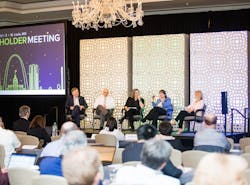Study Says Lighting Controls Boost LED Efficiency by 47 Percent
LED technology has made a huge impact on the world of lighting over the past decade. But today, the residential and commercial markets face different fates.
Energy savings opportunities in the residential arena will soon be “largely exhausted,” according to a recent study by Energy Futures Group (EFG). But in the commercial sector, potential savings remain significant.
The study notes that adding networked lighting controls to LED installations boosts energy savings by an average of 47% beyond savings from LEDs alone.
“The technology has been a lot quicker to adapt to the lamps in the residential market. With commercial, there’s just so many different applications, it’s been a little slower to transition to LED technology,” says Tina Halfpenny, executive director of the DesignLights Consortium (DLC), the Massachusetts-based national non-profit that sets efficiency standards for commercial lighting products that guide establishment of incentives by public utilities across the US.
Halfpenny adds that the savings potential continues to grow in the commercial space, particularly with interior lighting. Even if you’ve done a lighting retrofit in the past, first-generation lighting retrofits could be eligible for incentives and support if you transition to state-of-the-art lighting now.
“Efficiency gains have been pretty significant,” Halfpenny says.
Networked Lighting Controls
LEDs are one of the fastest ways to reduce energy consumed by buildings. According to EFG’s study, because of more stringent building codes, LEDs might soon be considered baseline for new construction projects.
[On topic: What You Need to Know About Human-Centric Lighting]
According to the study, the most significant savings in the commercial sector exist within:
- Linear LED lamps and fixtures
- Parking area/garage products
The study notes that adding networked lighting controls to LED installations boosts energy savings by an average of 47% beyond savings from LEDs alone.
“One thing DLC is focused on is trying to really educate and communicate the benefits of networked lighting controls,” Halfpenny says.
BUILDINGS Podcast
Rebates, Tax Incentives and Financing for Building Upgrades
[podcast]
Looking for tips on how to finance your building upgrades with rebates and tax incentives? Listen now >>
“It’s still a recent technology. It still has its bumps and warts, but potential is really significant—not only to bring energy savings, but also streamlined management of a building’s lighting system. There isn’t quite so much change required when you need to change your lights or building layout if you’ve gone with a networked system,” she continues.
These systems offer better personal comfort for tenants, as they can control lighting quality and intensity. Facilities managers can also use them as smart building features to observe areas that are unoccupied during certain times and, as a result, turn down HVAC and lights.
“All of these things really increase the flexibility and versatility of the lighting system,” Halfpenny explains.
She adds, “A lighting retrofit can seem really straightforward and cost-effective, particularly if there are utility incentive rebates associated with it. But if you can bring in controls, whether they be integrated controls or a networked system, you’re just going to be able to gain so much more out of it.”
What’s Next
As lighting systems become more sophisticated, one of the goals of the DLC is to try and bring an easy-to-access resource to facilities managers and lighting decision-makers. Its Qualified Products List is used by utilities nationwide to find verified, quality LED products.
[Check this out: The Impactful Benefits of this LED Lighting Retrofit]
“There are so many solution-based lighting systems out there now,” Halfpenny says. “It can be confusing. We’re trying to make that more straightforward and accessible with the tools we have, so that facilities managers and building owners can figure out what it is that they need.”
Based on this EFG study, the DLC hopes to drive up its baseline on efficacy. With LEDs and networked lighting controls, commercial facilities managers and utility programs “have the potential to capture significant lighting savings.”
If a lighting retrofit is in your near future, consider how networked lighting controls and LED can transform your energy load.
Two handpicked articles to read next:
About the Author

Sarah Kloepple
Associate Editor
Sarah joined the BUILDINGS team as an associate editor in August 2018. She is a graduate of the Missouri School of Journalism, where her focus was magazine writing. She's written and edited for numerous publications in her hometown of St. Louis.
